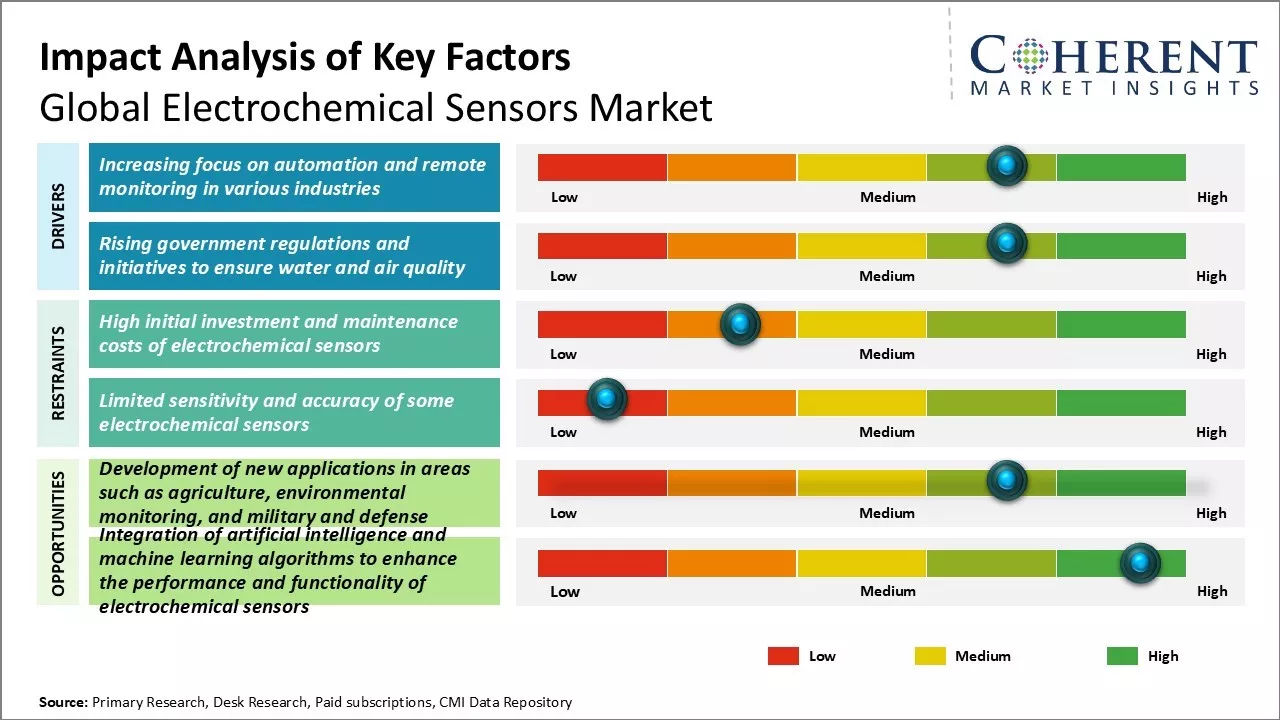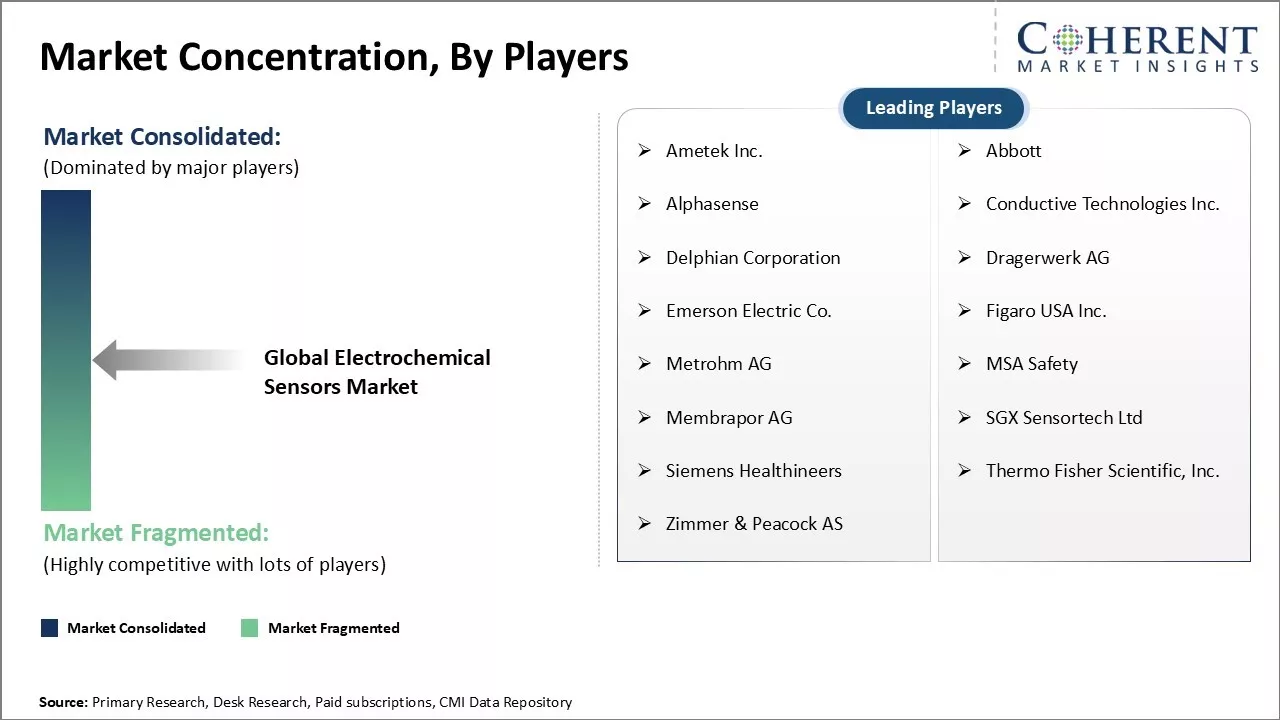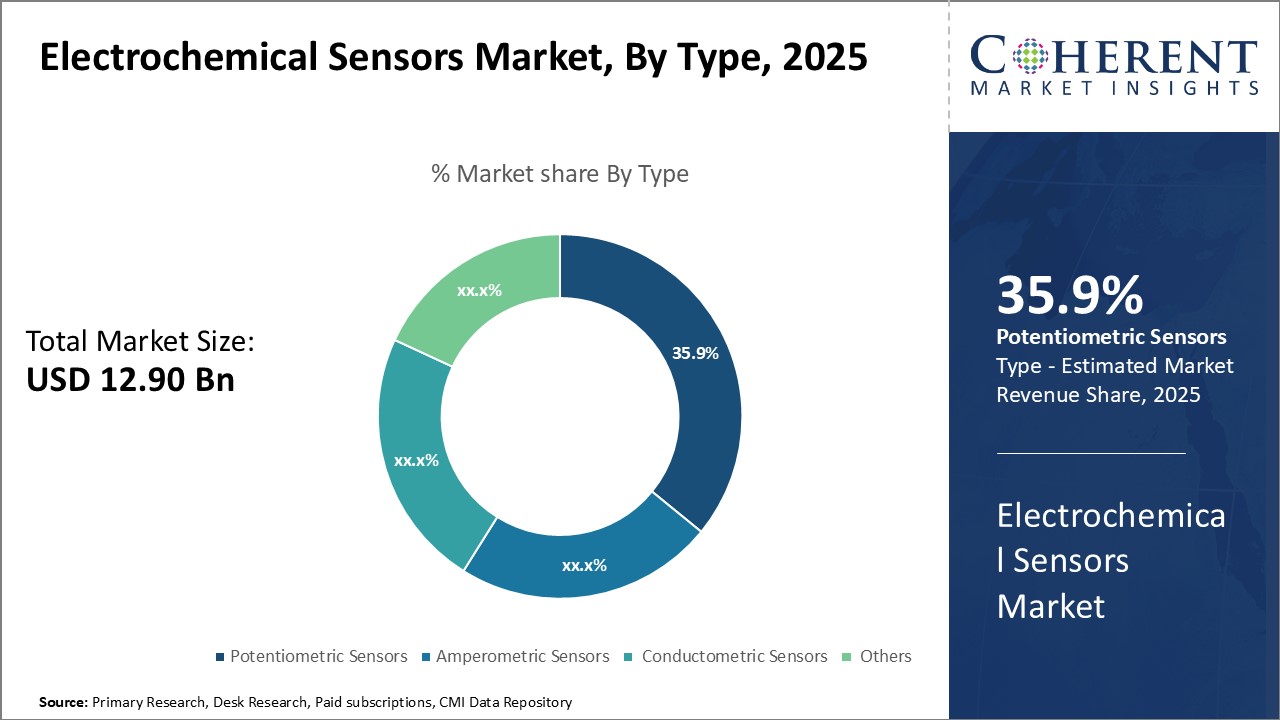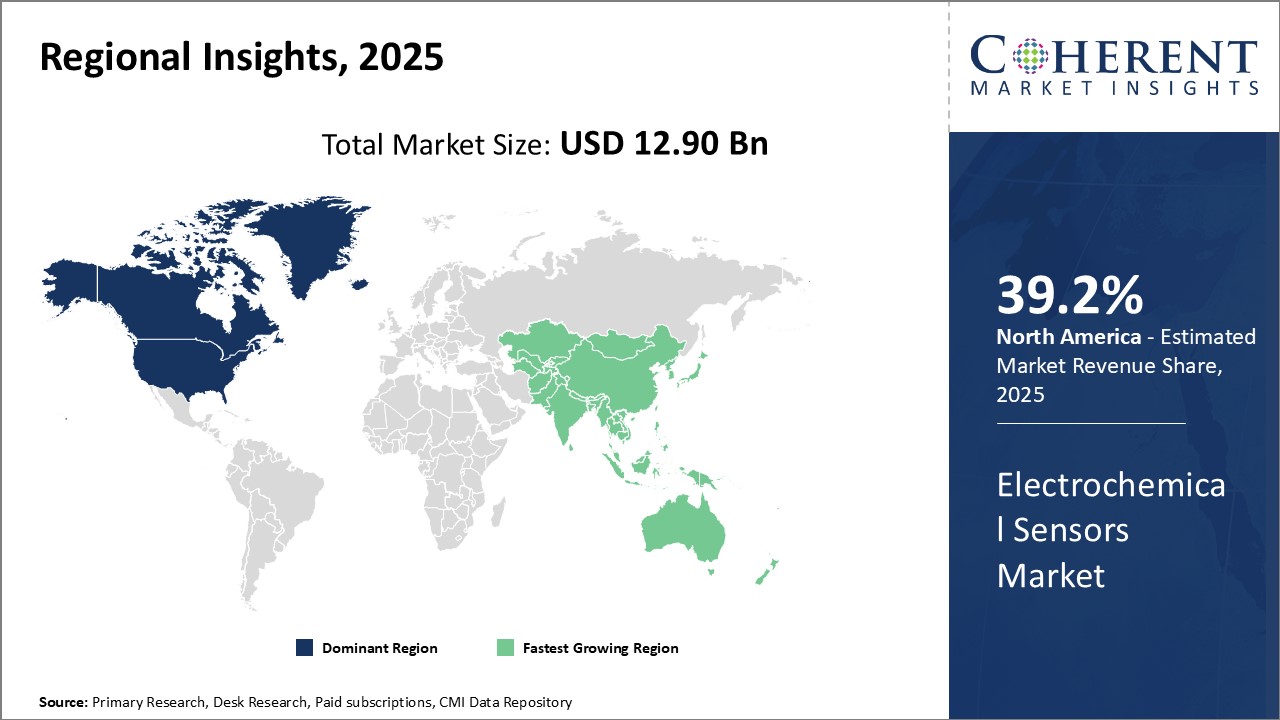Electrochemical Sensors Market Size and Trends
The global electrochemical sensors market is estimated to be valued at USD 12.90 Billion in 2025 and is expected to reach USD 23.15 Billion by 2032, exhibiting a compound annual growth rate (CAGR) of 8.7% from 2025 to 2032.

Discover market dynamics shaping the industry: Download Free Sample
Electrochemical sensors have wide applications in the medical devices, environmental monitoring, food quality control, and other industries which is supporting the market growth.
Increasing focus on automation and remote monitoring in various industries
Industries around the world are continuously focusing on automating their processes and moving towards Industry 4.0. This brings various advantages like increased productivity, reduced costs, improved quality, and real-time monitoring of operations from remote locations. To enable these automation initiatives, extensive use of various sensors is required which can capture data from equipment, machinery, and environments on the plant/production floor. This data is then analyzed to take corrective actions if needed and also enable remote monitoring. Electrochemical sensors are perfectly suitable in such applications due to their compact size, longer life, stability, and ability to operate without requiring frequent recalibration. Many industries like oil & gas, manufacturing, food processing, healthcare, etc. are increasingly deploying electrochemical sensor-based solutions for automation. For example, oil & gas companies are using electrochemical sensor-based systems for pipeline leak detection and monitoring tank levels from control rooms. Similarly, food processors are automating processes like monitoring dissolved oxygen and pH levels in tanks. With growing focus on automation across sectors to enhance efficiency, reduce costs, and ensure safety, the demand for electrochemical sensors is expected to increase significantly in the coming years.
Market Concentration and Competitive Landscape

Get actionable strategies to beat competition: Download Free Sample
Rising Government Regulations and Initiatives to Ensure Water and Air Quality
Governments across the world are enacting stricter regulations and taking various initiatives to monitor and improve the quality of water and air. They have realized that maintaining clean water sources and air quality is pivotal from health as well as environmental perspective. Various countries have established regulatory bodies which are formulating new guidelines and imposing penalties on violating them. For instance, agencies like the US Environmental Protection Agency (EPA) and European Union (EU) have strengthened norms pertaining to levels of pollutants that can be released into water bodies and atmosphere. They are also spending on extensive monitoring networks to regularly check the status of water sources as well as air quality levels in cities. Measuring various parameters like pH, dissolved oxygen, toxic gases, etc. requires reliable and accurate sensors. Electrochemical sensors have emerged as a go-to technology for such applications due to their small size, ability to monitor multiple parameters using single sensor, and relative ease of use. With growing focus of regulatory agencies on water and air quality monitoring across locations, the Electrochemical Sensors Market is expected to witness significant momentum.
Key Takeaways from Analyst:
Major drivers for Electrochemical Sensors Market include the growing demand for portable and wearable medical devices for real-time health monitoring. Electrochemical sensors are increasingly being used in implantable and wearable devices due to their miniaturized size and ability to provide continuous data. The rising prevalence of chronic diseases will further propel the demand for such sensors for monitoring vital parameters.
However, high manufacturing costs remain a key restraint. Production of electrochemical sensors involves complex microfabrication processes which increase costs. This may limit their usage in low-cost applications. Opportunities lie in developing innovative sensor designs with enhanced sensitivity, selectivity, and stability. Investments in R&D can help introduce more versatile sensor types.
North America, being an early adopter of new medical technologies, currently dominates the market. However, Asia Pacific is expected to witness the highest gains and emerge as the fastest-growing regional market. This can be attributed to rising healthcare investments, growing medical tourism and increasing prevalence of lifestyle-related diseases in developing Asian countries.
In summary, while high costs pose challenges, ongoing technological advancements are likely to strengthen opportunities for growth in applications across healthcare, food testing, environmental monitoring, and others.
Market Challenge - High initial investment and maintenance costs of electrochemical sensors
One of the major challenges faced by the global electrochemical sensors market is the high initial investment and maintenance costs associated with these sensors. Electrochemical sensors typically have a higher upfront cost compared to traditional sensors owing to the need for specialized materials and circuitry required in their manufacturing. Additionally, electrochemical sensors also need regular maintenance and calibration checks to ensure optimal performance over their lifespan. The calibration process requires additional equipment and labor costs. These higher initial procurement and ongoing maintenance expenditures pose a significant barrier for the widespread adoption of electrochemical sensors, especially in cost-sensitive and price-competitive end-use industries. The high costs impact the return on investment calculation for customers and hinders volume growth of the market. Sensor manufacturers need to focus on rationalizing costs through innovations in design and mass production to make these solutions more affordable.
Market Opportunities: Development of new applications in areas such as agriculture, environmental monitoring, and military and defense
One major opportunity for the continued growth of the global electrochemical sensors market lies in the development of new applications in diverse sectors. There is significant scope for electrochemical sensors to be increasingly used in applications related to agriculture such as soil analysis, water quality monitoring for irrigation, and detection of pathogens and ripeness of crops. Industries involved in environmental monitoring for assessing water and air quality can also adopt these sensors on a wider scale. Additionally, electrochemical sensors offer advantages over traditional sensing technologies in military and defense applications owing to their high sensitivity, small size, and durability. Their adoption is expected to increase in uses involving explosives detection at airports and other public places, toxic industrial chemical detection, and health monitoring of soldiers. The diverse new emerging application areas can boost overall demand and help drive the market forward in the coming years.

Discover high revenue pocket segments and roadmap to it: Download Free Sample
Insights By Type - Potentiometric sensors is expected to contribute 35.9% share of the market in 2025 owing to their affordable cost and accuracy in measurement
Potentiometric sensors measure the potential difference between two electrodes and provide output voltage directly proportional to concentration. They have a simple design using ion-selective electrodes which makes them very cost effective compared to other sensor types. Their electrodes also provide highly accurate readings even at low concentrations which is desirable for various applications. Potentiometric sensors find widespread use in pH and ion concentration measurement where affordability and precision are important decision factors for end users. The inexpensive production and replacement of electrodes as well as lack of need for complex circuitry has ensured potentiometric sensors remain the sensor of choice even as new technologies emerge. This significant cost advantage over other sensor types continue to drive their widespread adoption.
Insights By Application - Gas detection is expected to contribute 41.7% share of the market in 2025 owing to the versatility of gas sensors and their applicability across multiple industries
Gas sensors can detect a wide variety of target gases such as toxic, combustible, pollutant and reactive gases. They utilize different materials and electrochemical reactions for sensing different gases. This versatility makes them suitable for diverse applications ranging from indoor air quality monitoring to process leak detection. Moreover, gases play an important role across many industries like manufacturing, oil & gas, chemicals, healthcare, transportation and are strictly monitored for safety, regulatory and operational reasons. The ability of gas sensors to detect gases relevant to these industries drives their high demand. The large application scope across sectors ensures gas detection remains an integral part of process and quality control in multiple end use markets.
Insights By End User - Industrial is expected to contribute 40% of the market share in 2025 owing to stringent regulatory guidelines for workplace safety, emission control, and hazardous gas monitoring in industrial facilities
Industrial operations involve working with toxic substances, flammable materials and reactive chemicals which can endanger human health and environment if not properly handled and contained. Governments worldwide have established strict regulations and standards around industrial safety, pollution control, and risk management. Compliance to these rules requires continuous monitoring of workplace air quality, effluent treatment systems and leak detection equipment. Electrochemical gas, pH and ion selective sensors play a critical role in compliance by providing real-time detection and alerts. Industries invest heavily in safety instrumentation to avoid penalties, legal liability and shutdowns associated with non-compliance or accidents. The pressing need to adhere to safety norms drives greater usage of sensors in industrial end users.
Regional Insights

Need a Different Region or Segment? Download Free Sample
The North America region currently dominates the global electrochemical sensors market. The region is expected to hold 39.2% of the market share in 2025 owing to strong industrial presence and established manufacturing base in countries like the U.S. and Canada. With major industries utilizing electrochemical sensors for process monitoring and quality control, there is significant demand from sectors such as oil & gas, healthcare, food & beverages and automotive. Moreover, the presence of leading global players in the region has enabled easy access to cutting-edge electrochemical sensor technologies compared to other parts of the world.
One region that is poised to achieve the fastest growth in the electrochemical sensors market is Asia Pacific. Strong manufacturing growth in countries like China, India, Japan, and South Korea is supporting the increasing implementation of electrochemical sensors across industries. As these nations move up the industrial value chain and quality standards get more stringent, demand for sensing solutions is on the rise. Additionally, low input costs for sensor manufacturers have attracted global brands to set up local manufacturing units in the region through joint ventures and partnerships. This is enhancing the availability of affordable electrochemical sensors tailored for the local requirements. Government initiatives focused on making 'Make in India' and expanding domestic manufacturing are also encouraging greater research & development efforts towards new electrochemical sensor-based technologies.
Market Report Scope
Electrochemical Sensors Market Report Coverage
| Report Coverage | Details | ||
|---|---|---|---|
| Base Year: | 2024 | Market Size in 2025: | USD 12.90 Bn |
| Historical Data for: | 2020 To 2024 | Forecast Period: | 2025 To 2032 |
| Forecast Period 2025 to 2032 CAGR: | 8.7% | 2032 Value Projection: | USD 23.15 Bn |
| Geographies covered: |
|
||
| Segments covered: |
|
||
| Companies covered: |
Ametek Inc., Abbott, Alphasense, Conductive Technologies Inc., Delphian Corporation, Dragerwerk AG, Emerson Electric Co., Figaro USA Inc., Metrohm AG, MSA Safety, Membrapor AG, SGX Sensortech Ltd, Siemens Healthineers, Thermo Fisher Scientific, Inc., and Zimmer & Peacock AS |
||
| Growth Drivers: |
|
||
| Restraints & Challenges: |
|
||
Uncover macros and micros vetted on 75+ parameters: Get instant access to report
Electrochemical Sensors Industry News
- In October 2023, AMETEK, Inc. (NYSE: AME), a leading global provider of electronic instruments and electromechanical devices, announced the acquisition of Amplifier Research Corp., a major manufacturer of radio frequency (RF) and microwave amplifiers, as well as electromagnetic compatibility (EMC) testing equipment. This strategic move aims to enhance AMETEK's capabilities in the EMC testing market and provide a broader suite of solutions for attractive markets such as electric vehicle testing and defense communications.
- In March 2023, Abbott (NYSE: ABT), a global healthcare leader, announced that the U.S. Food and Drug Administration (FDA) cleared its FreeStyle Libre 2 and FreeStyle Libre 3 integrated continuous glucose monitoring (iCGM) system sensors for integration with automated insulin delivery (AID) systems. The FreeStyle Libre portfolio is the world's leading sensor-based glucose monitoring system, having changed the lives of 4.5 million people across more than 60 countries.
- In August 2022, Thermo Fisher Scientific (NYSE: TMO), a global leader in serving science, announced the establishment of the Centre of Excellence for DNA Forensics in collaboration with the National Forensic Sciences University (NFSU) in India. This pioneering facility, located on the NFSU campus in Gujarat, is equipped with a comprehensive DNA workflow, including advanced systems for DNA extraction, real-time PCR instruments, DNA sequencers, next-generation sequencers, and rapid DNA technologies. The center aims to enhance training and education for forensic scientists and law enforcement professionals, while versatile electrochemical DNA/RNA sensors are emerging as a promising alternative for PCR-based diagnostics.
- In February 2022, Thermo Fisher Scientific Inc. (NYSE: TMO), the world leader in serving science with annual revenue of approximately $40 billion, announced a 15-year strategic collaboration agreement with Moderna, Inc. (Nasdaq: MRNA), a biotechnology company pioneering messenger RNA (mRNA) therapeutics and vaccines. The agreement aims to enable dedicated large-scale manufacturing in the U.S. of Spikevax, Moderna's COVID-19 vaccine, and other investigational mRNA medicines in its pipeline.
*Definition: The global electrochemical sensors market involves sensors that use electrochemical principles to detect chemical compounds and generate electrical signals related to their concentration or activity. These sensors are used across industries like healthcare, environmental monitoring, food & beverage, oil & gas, and manufacturing to measure parameters like pH, dissolved oxygen, toxin presence, and heavy metal contamination.
Market Segmentation
- By Type Insights (Revenue, USD Bn, 2020 - 2032)
-
- Potentiometric Sensors
- Amperometric Sensors
- Conductometric Sensors
- Others (Voltammetric, Galvanic, etc.)
- By Application Insights (Revenue, USD Bn, 2020 - 2032)
-
- Gas Detection
- pH Measurement
- Ionic Concentration Measurement
- Biosensing
- Others
- By End User Insights (Revenue, USD Bn, 2020 - 2032)
-
- Industrial
- Environmental Monitoring
- Healthcare
- Automotive
- Others
- By Regional Insights (Revenue, USD Bn, 2020 - 2032)
-
- North America
- U.S.
- Canada
- Latin America
- Brazil
- Argentina
- Mexico
- Rest of Latin America
- Europe
- Germany
- U.K.
- Spain
- France
- Italy
- Russia
- Rest of Europe
- Asia Pacific
- China
- India
- Japan
- Australia
- South Korea
- ASEAN
- Rest of Asia Pacific
- Middle East
- GCC Countries
- Israel
- Rest of Middle East
- Africa
- South Africa
- North Africa
- Central Africa
- North America
- Key Players Insights
-
- Ametek Inc.
- Abbott
- Alphasense
- Conductive Technologies Inc.
- Delphian Corporation
- Dragerwerk AG
- Emerson Electric Co.
- Figaro USA Inc.
- Metrohm AG
- MSA Safety
- Membrapor AG
- SGX Sensortech Ltd
- Siemens Healthineers
- Thermo Fisher Scientific, Inc.
- Zimmer & Peacock AS
Share
Share
About Author
As an accomplished Senior Consultant with 7+ years of experience, Pooja Tayade has a proven track record in devising and implementing data and strategy consulting across various industries. She specializes in market research, competitive analysis, primary insights, and market estimation. She excels in strategic advisory, delivering data-driven insights to help clients navigate market complexities, optimize entry strategies, and achieve sustainable growth.
Missing comfort of reading report in your local language? Find your preferred language :
Transform your Strategy with Exclusive Trending Reports :
Frequently Asked Questions
EXISTING CLIENTELE
Joining thousands of companies around the world committed to making the Excellent Business Solutions.
View All Our Clients
